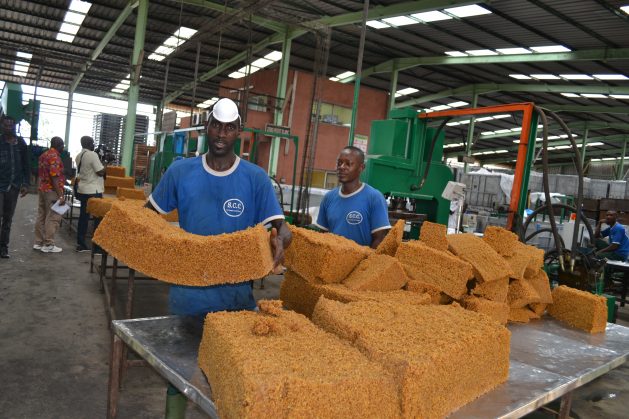DAR ES SALAAM, Sep 15 (IPS) – Experts at the Africa Food Systems Forum (AGRF) in Dar es Salaam, Tanzania, have called on African governments to make and review existing policies to protect the processing and agro-industrialisation of locally produced agricultural products.
During the launch of the Deal Room, Mohammed Dewji, President of MeTL Group of Companies in Tanzania, observed that agriculture will remain meaningless without agri-processing. https://www.ipsnews.net/2021/05/kenyas-dryland-farmers-embrace-regenerative-farming-to-brave-tough-climate/
“Tanzania produces cotton, and it is perhaps the third largest producer. How come it has only three textile firms? We are farming the cotton, ginning it, and exporting the same to China, where the final product is produced, died, and printed, and then it is sent back to us. Because of taxes involved at the local manufacturing level, we cannot compete,” he said.
“Unless we put in place correct policies that will favour local manufacturing, we will continue talking about cocoa from Ghana and chocolate from Switzerland,” he told delegates at the Deal Room.
The Deal Room is a matchmaking platform hosted at the AGRF, aiming to drive new business deals and commitments, where companies in the agriculture and agribusiness sectors can access finance, mentorship, and market entry solutions to support their growth objectives.
According to Wanjohi Ndagu, the Partner and Investment Director at Pearl Capital Partners Ltd based in Uganda, many African governments have policies that favour importation even when farmers in those countries have bumper harvests of the same product.
“We need policies that are able to protect farmers and local production,” he said.
Other than cocoa in Ghana and chocolate from Switzerland, countries like Ivory Coast and Nigeria are net exporters of natural rubber, which is processed and brought back to them as car tyres, footwear, and rubber-based industrial goods.
Tanzania, Mozambique, and Ivory Coast are net exporters of cashew nuts but importers of roasted and processed cashew nuts, cashew butter, and other value-added cashew products.
Kenya is currently delving into the exportation of raw avocado, but the country has always imported particularly avocado cosmetic products.
However, all is not lost.
Rwanda was showcased as one of the success stories in Africa where, through favourable policies, the country has created a conducive environment attracting investment into the agro-processing sector.
“Our country’s Strategic Plan for Agriculture Transformation has enabled us to move the sector from subsistence to a knowledge-based, value-creating sector,” said Nelly Mukazayire, the Deputy CEO of the Rwanda Development Board (RDB).
To make work more accessible and attractive to investors, the country has created a one-stop-centre where investors in any given sector, including agro-processing, are given services right from the search for a business name, business registration, generation of unique identification of the registered business, the opening of the business bank account and issuance of relevant permits and licenses, and the entire process takes a maximum of eight hours for the business to become a legal entity.
In many other African countries, such processes can take more than four months and, in some cases, a year for a business to get proper registration, and this, according to the delegates at the AGRF, slows down the rate of investment.
“Investors in the agriculture sector in Rwanda also have an opportunity to get up to seven years of tax holiday and reduced corporate income taxes on exports,” said Mukazayire.
After the COVID-19 pandemic, the country launched what is today known as the Manufacture and Build to Recover Programme (MBRP), aiming to boost economic recovery efforts with specific incentives for the manufacturing, agro-processing, construction and real estate development sectors.
Through MBRP, manufacturers with a capital of USD1 million and above are given import duty exemption and Value Added Tax (VAT) exemption for imported construction materials unavailable in East Africa, VAT exemption for machinery and raw materials sourced domestically and VAT exemption for construction materials sourced domestically.
However, the capital for agro-processing was capped at USD 100,000 to support the sector’s growth.
During the AGRF Deal Room event, Brent Malahay, the Chief Strategy Officer at the Equity Group, called on investors to take advantage of the bank’s ‘Africa recovery and resilience plan,’ whose aim is to capacitate, finance and connect East African Community value chains to global supply chains.
“Through this plan, Equity Group will leverage off a region that gives access to critical raw materials, supports industrial capacity needs and an entrepreneurial and innovative local workforce, and the one that provides a sizeable market that is increasingly becoming more integrated,” said Malahay.
During the event, Isobel Coleman, Deputy Administrator at the United States Agency for International Development (USAID), announced an investment of USD4 million into VALUE4HER, AGRA’s Deal Room product, which is a continental initiative aimed at strengthening women’s agribusiness enterprises and enhancing voice and advocacy across Africa.
IPS UN Bureau Report
Follow @IPSNewsUNBureau
Follow IPS News UN Bureau on Instagram
© Inter Press Service (2023) — All Rights ReservedOriginal source: Inter Press Service
Check out our Latest News and Follow us at Facebook
Original Source

